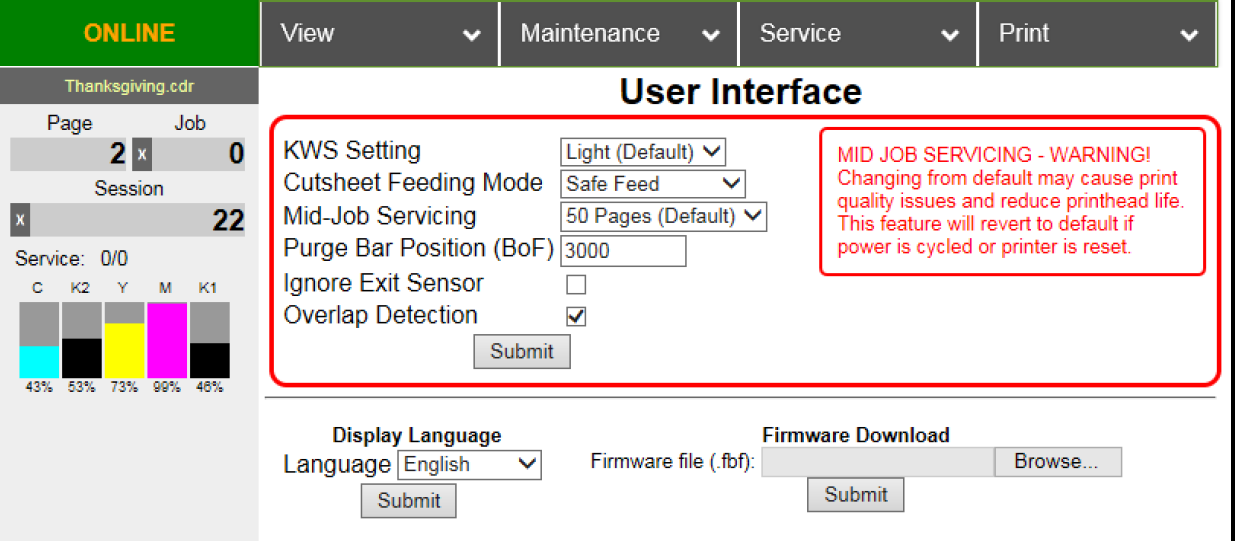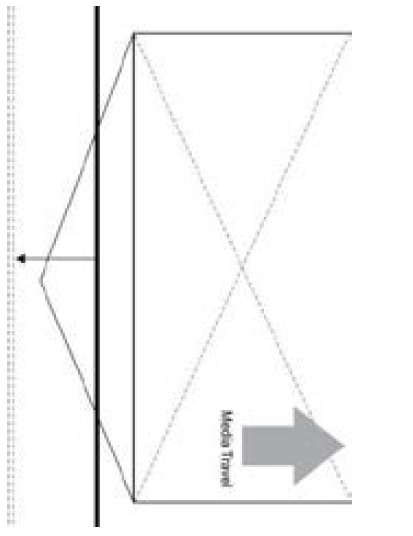User Interface View
USER INTERFACE ViewSETUP Settings – Select “View”, then “User Interface” to open the User Interface menu. You can adjust automated service and cleaning intervals, adjust the feed mode, manually set the purge bar location and disable/enable items that may help to detect a paper jam/misfeed or eliminate false detection. KWS Setting – (Keep Wet Spitting) Incorporates an algorithm to periodically fire all printhead nozzles, for the purpose of helping to keep all nozzles wet; thereby reducing nozzle dehydration/clogging and print quality issues. In general, the dots produced on the media, by this nozzle firing algorithm, are hardly noticeable. However, in some cases, the dots produced are not acceptable for the application and the user may wish to turn this feature off (set it to None). None - Intrapage spitting is turned off. KWS dots are not sprayed onto media. WARNING: Selecting “None” will increase chances for nozzle clogging and print quality issues. Light (Default) - Intrapage spitting frequency is set to the "default" level. KWS dots are sprayed onto media to help reduce nozzle clogging and print quality issues. Heavy - Intrapage spitting frequency is increased. An increased number of KWS dots are sprayed onto media to further reduced nozzle clogging and print quality issues. NOTE: KWS choices are limited by the “Mid-Job Servicing” selection. - Mid-Job Servicing set to 50 or 100 pages = KWS selections: None, Light, Heavy - Mid-Job Servicing set to 250, 500 or 1000 pages = KWS selections: Light or Heavy - Mid-Job Servicing is set to 2500 pages = KWS will automatically be set to Heavy Cutsheet Feeding Mode – Permits you to change how the Printer feeds media, depending on the type of job you are running. By default, this value is set to “Safe Feed”. Safe Feed – Larger gap between pieces provides slower throughput, but less chance for blanks (unprinted pieces) to be fed. Max_Throughput – Smaller gap between pieces provides higher throughput, but expect blanks (unprinted pieces) to be fed at end of job and whenever there is a pause in job. Mid-Job Servicing – Allows the user to adjust the frequency of printhead cleaning (maintenance) during a print job. The values provide page-based frequency control. The following choices are available: 50 (default)*, 100, 250, 500, 1000 or 2500 pages. *Use 50 Pages (Default) setting only with media at least letter-sized or A4 length or longer. CAUTION: Changing this setting from “50 pages (default)” may increase print quality issues and reduce printhead life. The selection you make will also affect the KWS choices. See “KWS Setting”. NOTE: This setting does not have any effect on the automatic maintenance tasks that are performed at start and end of job or anytime the printer is interrupted (paused, out of paper, paper jam, etc.). Purge Bar Position (BoF)* – During normal operation, the Printhead spits (purges) a small amount of ink, into the gap between pieces. This is done to keep the nozzles clear and hydrated. The “Purge Bar Position” feature allows the operator to manually adjust the location where the “Purge Bar” (nozzle purge) occurs. This feature is particularly useful when feeding irregular shaped media. 1000 = 1 mm. By default, this value is normally set to 3000 (3 mm). Example: When feeding envelopes with an open, v-shaped flap (flap trailing); the Paperpath Entry Sensor will see the trailing edge of the media too soon, causing the “purge bar” to print onto the trailing edge of the open flap. In this case the “Purge Bar Position” value should be increased by the distance measured from the purge bar to the end of flap, plus 3000 (3 mm). Tip: If you notice excessive ink accumulation on the Print Platen; it is recommended that you contact your service support representative and ask them to set the “interpage_freq” feature, located in the Toolbox Service Menus, to a higher value. Default = 1 Page (purge is preformed between each page). Clean the platen, and then test thoroughly to see if this change produces results that are more acceptable. CAUTION: Setting the “interpage_freq” feature to a higher value may reduce ink accumulation on the print platen, but it may also increase nozzle dehydration (clogging). * See also “Purge Bar Position” in the “Printer Driver Properties” section. Values are cumulative. Ignore Exit Sensor – Disables the detection of a “paper jam” under certain conditions. Allows use of media that is non-reflective to the Paperpath Exit sensor. When this feature is NOT selected; non-reflective areas, on the underside of the media, may cause a false “paper jam” condition. The Toolbox will display "Paperpath_Paperjam". After you select this feature and click on Submit, you will see the "Paperpath Exit" condition, shown in the Toolbox, change to "Exit: Disabled”. NOTE: Please try cleaning sensors; as outlined in the user's guide; before selecting this feature. This feature will not solve issues caused by media transport (slipping, hesitating) or a damaged Exit Sensor. Overlap Detection - Uses the Paperpath Entry sensor to monitor changes in media density. IMPORTANT: Overlap Detection is set to off (unchecked) by default. Please be sure Overlap Detection is off (unchecked) when feeding envelopes or media that contains variations in media thickness/density. This feature should only be used when feeding media that is of a single thickness/density (like single sheets of paper). If this feature is enabled (box checked) and the media density changes significantly; the printer assumes this is caused by overlapping media. In this case, the printer will stop and the toolbox will initially display “PAPERPATH_PAGE_SEQUENCE” and the PAPER key will flash. Then the Toolbox display may change to “PAPERPATH_PAPERJAM”. After the paper path has been cleared; Press the Pause/Resume button, in the Toolbox or on the Printer’s Control Panel, to “Resume” printing. The current page will be automatically reprinted and the remaining job will continue printing. PLEASE BE SURE TO HIT "SUBMIT" AFTER CHANGING THESE SETTINGS |   |
